
Spider Mites
Spider mites will be found in spruce, pine, honey locust, elm, linden, and other conifer and hardwood trees and shrubs. These tiny arthropods are less than 1 mm long and vary in color from yellow to red to green. Mites live over winter as eggs on the tree. There are many generations per year. Mites feed on sap and spin a fine silk webbing among needles (leaves). The damaged leaves become stippled, bleached, and brown,

Pine Needle Scale
Pine Needle Scales are mostly found in pine and spruce trees. Mature scales are tiny insects that are covered by a white, oblong, waxy protective covering that is 2.5 to 3 mm in length. Scales overwinter as eggs beneath female scales on the needles. In eastern Nebraska, crawlers hatch in mid-May and migrate to new needles on the tree. The crawlers then molt to an immobile nymph stage that feeds on the sap and secretes
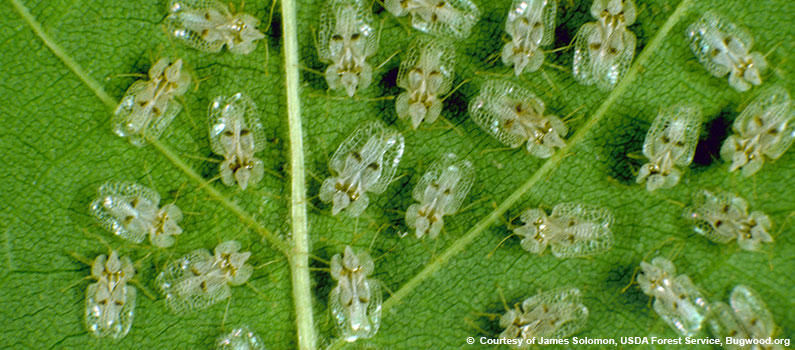
Lace Bug
Most lacebugs are found in elm, hackberry, oak, sycamore, basswood, and other hardwood trees. Adults are flat, 5 to 6 mm long, and dark-colored with highly sculptured (lace-like) white wings. There are usually two overlapping generations per year; thus all life stages can be found on the lower surface of leaves throughout the summer. Lace bugs overwinter in protected places on the tree. Infested leaves have brown or yellow stippling from feeding punctures and tar-like
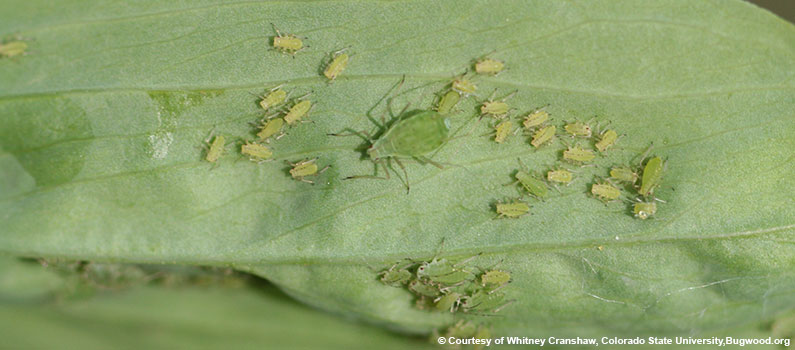
Aphid
Aphids are sucking insects that build up to huge numbers on tender new shoots and leaves. A black stain known as “sooty mold” is a problem beneath infested trees. Boxelder aphids are light to dark olive-green, and 2 to 2.5 mm long. Wings, if present, are held above the body. They overwinter as eggs on the host plant. Nymphs hatch in spring and develop into wingless adult females that reproduce without mating and give birth
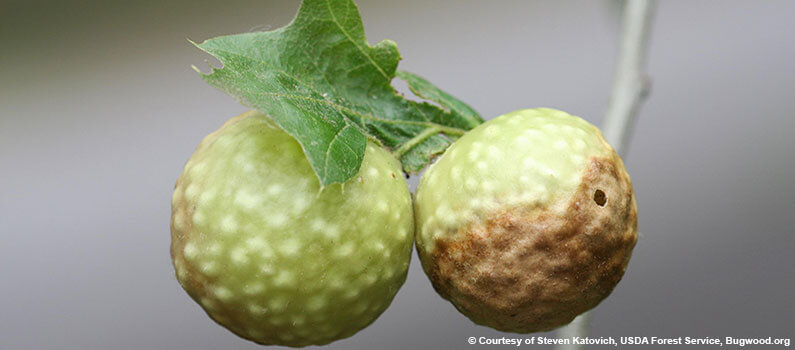
Oak Leaf Gall
Information on the identity, life cycle, and control of most of these wasps is sketchy. Numerous species of cecidomyiid and cynipid wasps cause the formation of galls on the leaves, leafstalks, and stems of oaks. Oak-apple galls, which are found on midribs and petioles of leaves, are typical. They are caused by several species of very small wasps, the most common being A. confluenta. Life cycles of these insects probably involve alternate generations of different
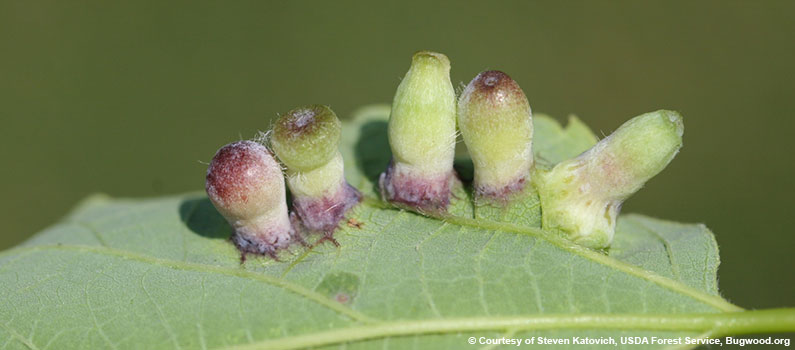
Hackberry Nipplegall Maker
Adult psyllids are about 4 to 5 mm long, and look like miniature cicadas. The tiny, yellowish nymphs rapidly become enveloped by gall tissue and are rarely seen. Nipplegalls are light green, nipple-shaped, and about 4 mm in diameter. Blistergalls are 3-4 mm in diameter, green, and slightly raised. Psyllids overwinter as adults in bark cracks and crevices. After mating in spring, females lay eggs on new growth. Nymphs feed on new growth all summer,
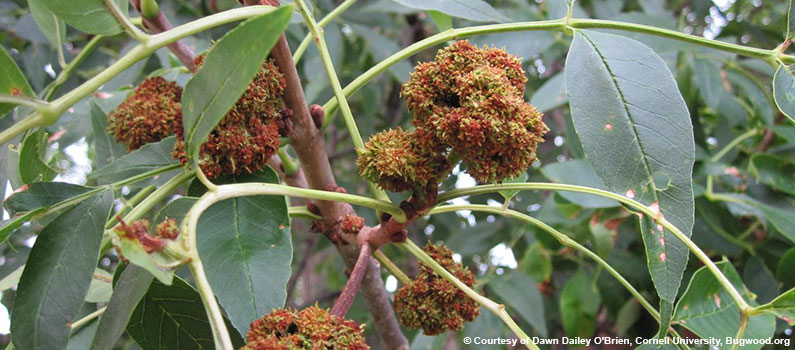
Ash Flower Gall Mite
Understanding the Ash Flower Gall Mite The Ash Flower Gall Mite is a tiny pest that targets ash trees, creating distinctive and often unsightly galls in male flower clusters. Scientifically known as eriophyid mites, these insects measure less than 1 mm in length and range in color from yellowish and greenish to reddish and red. Each mite species produces its own characteristic gall, with ash flower gall mites causing particularly visible damage. Under favorable conditions,
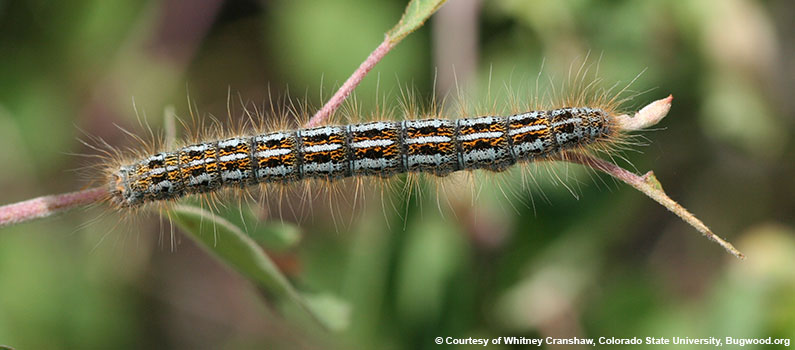
Prairie Tent Caterpillar
The Prairie Tent Caterpillar (Malacosoma Californicum Lutescens) is mostly found in chokecherry, plum, willow, ash, poplar, and rose trees. Mature larvae are 50 mm long and can be quite variable in pattern. In general, most prairie tent caterpillars are pale blue with an interrupted white stripe bordered by two reddish-orange stripes down the center of the back. Eastern tent caterpillars (Malacosoma Americanum) are similar but have a continuous white stripe down the back and black
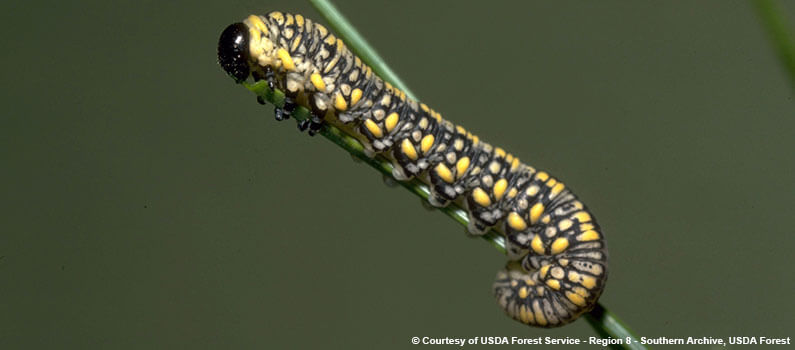
Pine Sawfly
Pine Sawflies can be found in Ponderosa, Scotch, Austrian, and Jack Pine trees. Sawfly larvae have eight pairs of prolegs and vary in color from grayish to yellowish-green. Some species have one or more longitudinal stripes. Mature larvae may reach 18 to 25 mm in length. Adult sawflies resemble small bees. The life cycle and number of generations varies with the sawfly species. Most species overwinter as pupae or prepupae, a few as eggs. In
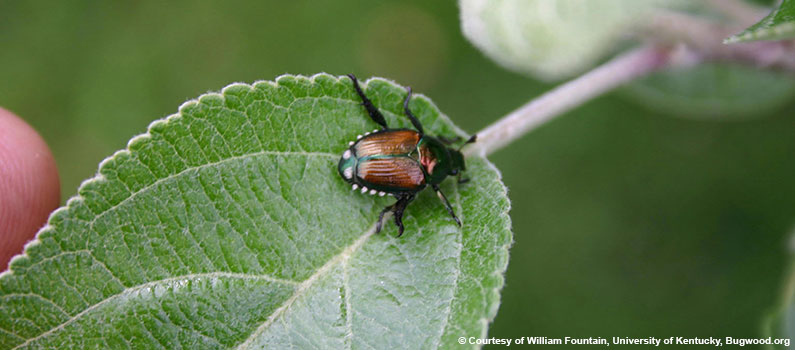
Japanese Beetle
The Japanese beetle feeds on the leaves, flowers, and fruit of a wide range of landscape plants. The grubs feed on the roots of many plants and are often damaging to lawns. The adult beetle is approximately 15mm long, with iridescent copper-colored wings and a green head and body. Natural predators restrict damage in its native Japan, but in North America it is a serious pest, feeding on about 200 different species of plants, including
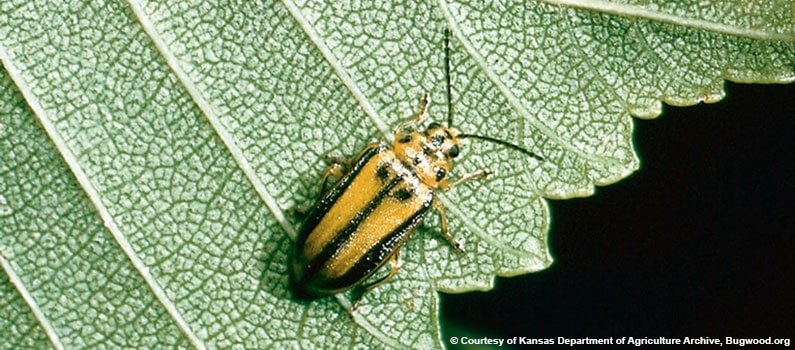
Elm Leaf Beetle
The larvae of this beetle consume the leaves of elms, leaving only veins of the foliage. The adult beetles are often a nuisance when they winter in buildings. Larvae are 16mm or smaller, and are a blackish color, sometimes black and yellow, with multiple rows of dots down its back and sides. The adult beetle is approximately 6-8mm in length. It ranges from yellow to green in coloring, with a characteristic spot on its head,
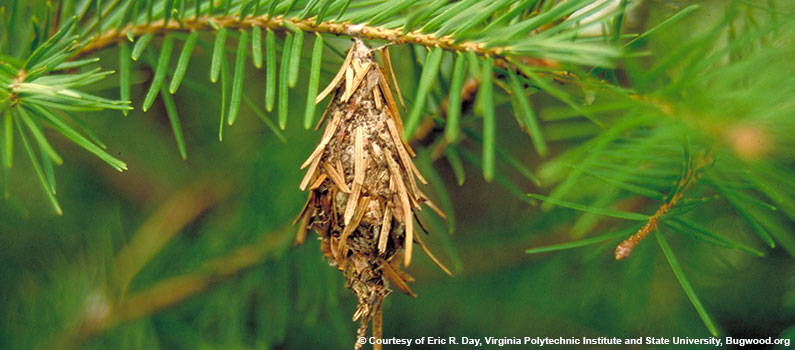
Bagworm Moth
Caterpillars, pupae, and adult male bagworms live inside bags constructed of silk, twigs, and larvae which hang from trees. Full grown larvae are 18 to 25mm long and dark brown. Bags of mature larvae are 30 to 50 mm long. Female bagworms are yellowish-white, wingless, maggot-like moths that do not have functional legs, eyes, or antennae. Male moths are sooty, black, and hairy, and have a wingspan about 25 mm. Eggs winter within the bags
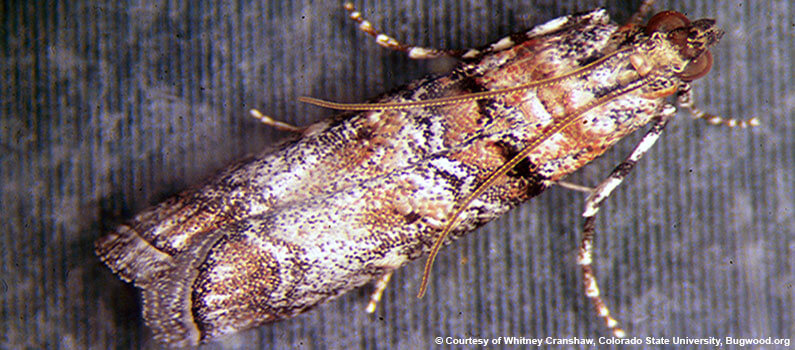
Zimmerman Pine Moth
The larvae of the Zimmerman Pine Moth damages trees by tunneling just beneath the bark of the trunk and branches, most commonly on the trunk just below a branch. The tunnels they make can girdle the trunk or branches or physically weaken them so they are easily broken by wind or snow. Heavily infested trees are often deformed and sometimes succumb to the pest, which usually emerges in August in Nebraska.
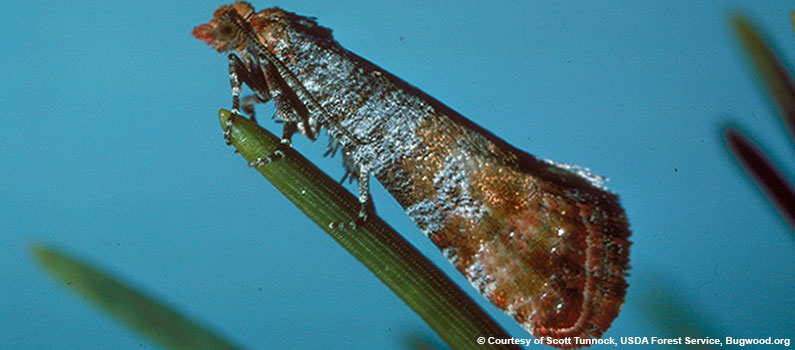
Pine Tip Moth
These moths will create new shoots mostly on Ponderosa, Austrian, Scotch, and Jack Pine trees. Larvae vary from yellowish-white to pink to reddish-orange, with dark heads. Mature Nantucket and Western Pine Tip moth larvae are 9 to 12 mm long; mature southwestern pine tip moth larvae are 12 to 15 mm long. Coloration and wingspan of the moths varies with the species; however, most are a mottled reddish-brown and gray. Nantucket Pine Tip moths live
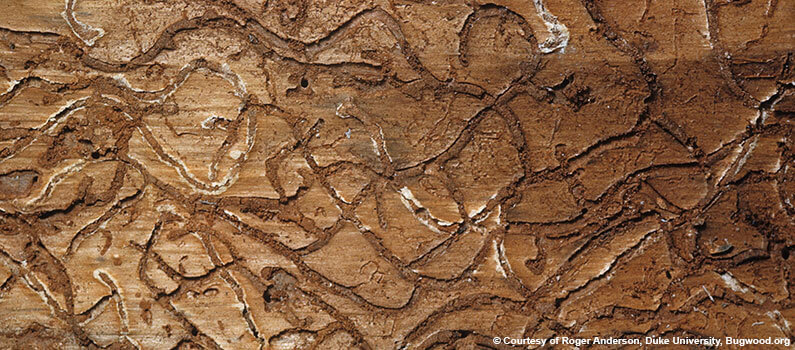
Pine Bark Beetle
Several species of bark beetles breed in pines in the Great Plains. Larvae are usually C-shaped, legless, and white with brown heads. Adults range from 3 to 10 mm long and are brown or black. If winters are not severe enough, most bark beetle species can live over winter as adults, larvae, or eggs. Eggs are laid in galleries constructed between the bark and wood, and larval feeding galleries radiate from these egg galleries. The
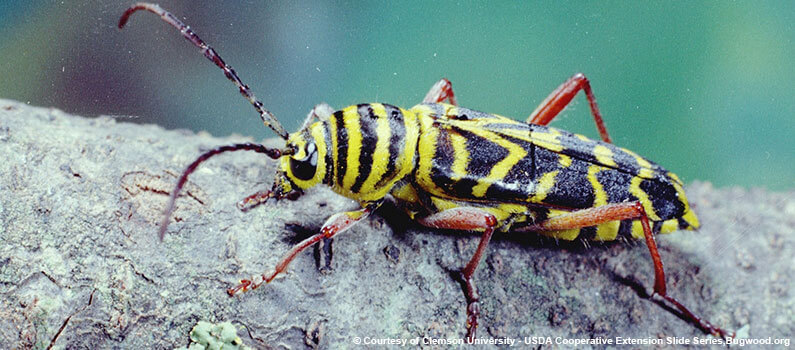
Locust Borer
The Locust Borer is so-named because its primary target is Black Locust trees. Mature larvae are 25 mm long and white with dark heads. Adult beetles are about 18 mm long and black with bright yellow bands across the thorax and wing covers. The third band on the wings forms a “w” design. Beetles emerge in late summer and early fall and are commonly seen on goldenrod flowers. In the fall they deposit eggs in
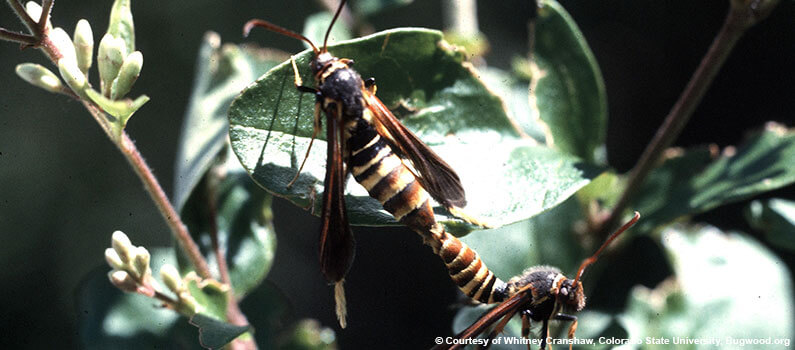
Lilac Ash Borer
The adult Ash Borer (or Lilac Borer, not to be confused with the Emerald Ash Borer) is a clear-winged, day-flying moth that closely resembles a wasp. The adults emerge in August or September and deposit eggs on the bark of the lower trunk. The larvae hatch out, then bore through the bark and feed within the branches and trunk of the tree until the following fall, when they emerge as adults.
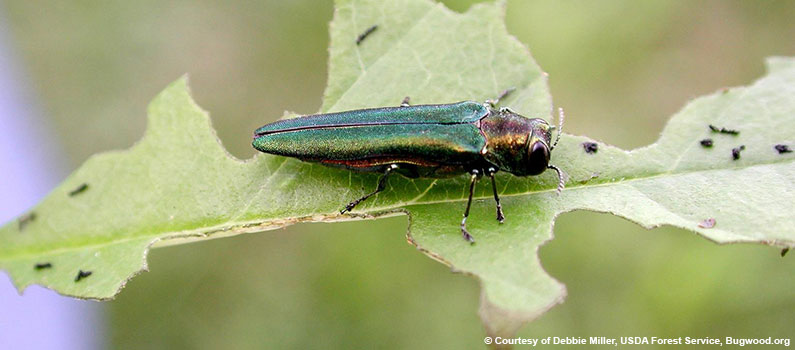
Emerald Ash Borer
The Emerald Ash Borer (EAB) is a highly invasive, non-native insect that attacks and kills all species of North American ash trees, including white, green and black ash. Latest research indicates that it may have spread to the white fringetree as well. EAB is native to Asia and was first detected in the U.S. in summer of 2002 feeding on ash trees in the Detroit area. It has been confirmed in Colorado, Kansas, Missouri and
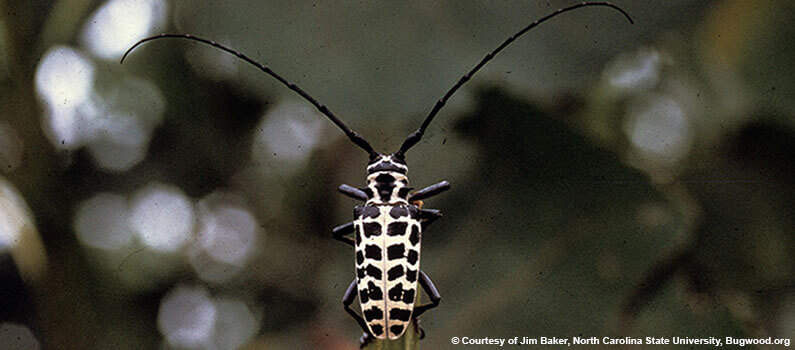
Cottonwood Borer
Cottonwood Borer larvae are cream-colored and reach 32 to 38 mm in length. The adult beetles are black and white and 25 to 35 mm long with antennae nearly as long as the body. The beetles emerge during late spring and summer and feed on tender shoots of young trees. Females lay eggs in bark at the bases of trees. Larvae emerge in 10 to 14 days and mine tunnels in the lower trunk and
